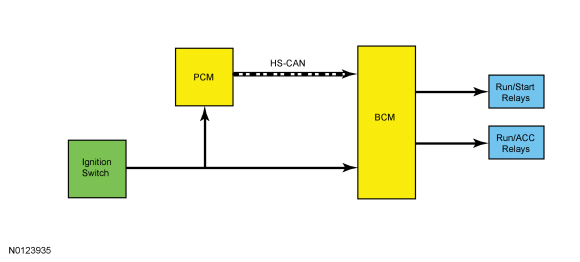SECTION 211-05: Steering Column Switches
| 2014 Flex Workshop Manual
|
DESCRIPTION AND OPERATION
| Procedure revision date: 05/02/2013
|
Overview
The conventional ignition switch is controlled by the ignition lock cylinder and key. The ignition lock cylinder and ignition switch are connected mechanically, turning the lock cylinder places the switch into the desired position. The available ignition switch positions are:
When placed in any position other than OFF, the ignition switch provides voltage inputs to the BCM . The BCM distributes this voltage to other modules and vehicle systems through the RUN/ACC and the RUN/START relays. The microprocessor internal to the BCM broadcasts an ignition mode network message over the MS-CAN and the HS-CAN .
System Operation

OFF
When the ignition switch is turned to the OFF position, the BCM sends an “engine off” message to the other modules over the HS-CAN .
ACC
When the BCM receives the ACC voltage input from the ignition switch it activates the RUN/ACC bus and the RUN/ACC relay, providing ignition accessory power to the various vehicle systems and modules. The BCM also sends out the ignition mode message on the MS-CAN and the HS-CAN .
RUN
When the BCM receives the RUN voltage input from the ignition switch it activates the RUN/ACC bus, the RUN/START bus, the RUN/ACC relay and the RUN/START relay, providing ignition power to the various vehicle systems and modules. The BCM also sends out the ignition mode message on the MS-CAN and the HS-CAN .
START
When the BCM receives the START voltage input from the ignition switch it activates the RUN/START bus and the RUN/START relay, providing ignition power to the various vehicle systems and modules. The BCM also sends out the ignition mode message on the MS-CAN and the HS-CAN .
The ignition switch START circuit is also hard wired to the PCM. The PCM uses the ignition switch START input to determine when to activate the starter motor relay. Refer to Section 303-06 .
Component Description
Ignition Switch
The ignition switch is a multiple position, rotary switch that is controlled by a lock cylinder and a key. The switch is hardwired to the BCM , PCM and the BSIA .
The key removal inhibit solenoid (also known as the key release interlock actuator) is an electronically controlled solenoid that prevents the ignition lock cylinder from being turned to the OFF position unless the gear selector lever is in the PARK position. The key removal inhibit solenoid is part of the ignition switch.
BCM
The BCM determines the vehicle ignition mode based on the ignition switch input. The BCM communicates the ignition mode to the other modules over the MS-CAN and the HS-CAN . The BCM monitors the ignition switch input and the ignition mode outputs. If a fault is detected in the ignition system, DTCs will be set by the BCM . Refer to Section 419-10 .